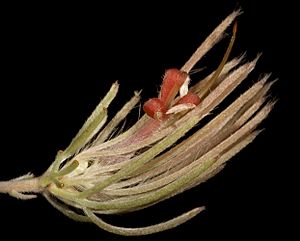Adenanthos oreophilus facts for kids
Quick facts for kids Adenanthos oreophilus |
|
|---|---|
 |
|
| Scientific classification | |
| Genus: |
Adenanthos
|
| Species: |
oreophilus
|
The Adenanthos oreophilus, often called woollybush, is a tall shrub found only in the southwest part of Western Australia. It is very similar to another well-known plant, the A. sericeus (Albany woollybush). For a long time, people thought they were the same plant. But in 1978, a botanist named E. Charles Nelson decided it was a separate species.
What it Looks Like
Adenanthos oreophilus grows straight up, reaching about 2 meters (7 feet) tall. It has branches that also grow upwards. Unlike some plants, it doesn't have a special woody base (called a lignotuber) that helps it regrow after fires.
Its leaves are deeply divided into long, soft, thin parts, like fingers. Each leaf usually has three or five of these finger-like sections. The flowers are a bright scarlet (red) color. The main tube part of the flower is about 27 to 35 millimeters long, and the style (a part of the flower) is around 40 millimeters long.
This plant looks a lot like its close relative, A. sericeus. Their flowers are almost identical. However, the leaves of A. sericeus have many more thin sections than the leaves of A. oreophilus.
How Scientists Classify It
Scientists have been collecting samples of this plant since the mid-1800s. For many years, they thought it was just a different type of A. sericeus. But in 1978, an Irish botanist named E. Charles Nelson officially named it as its own species.
Nelson studied a plant he collected in 1973 from East Mount Barren in the Fitzgerald River National Park. He gave it the name oreophila. This name comes from two Ancient Greek words: oreos, meaning "mountain," and philos, meaning "beloved." So, the name means "mountain-loving," because this plant is only found on mountain ranges. Later, the rules for naming plants changed, so its name became A. oreophilus instead of A. oreophila.
Nelson placed A. oreophilus into a group called A. sect. Adenanthos. This group includes plants where the flower tube is mostly straight.
Where it Grows
Adenanthos oreophilus grows in a few separate places, which is unusual for an Adenanthos plant. The main groups of these plants are found on East Mount Barren and south towards the Fitzgerald River. But there are also other groups far away, like at Mount Desmond, Mount Ragged, and a hill called 'Hill 62'. These last two spots are about 500 kilometers (310 miles) east of the Barren Ranges.
This plant likes to grow on rocky hillsides. It can be found in special types of soil, like laterite or sandy soil, among tall scrub plants.
Growing it in Gardens
Botanist E. Charles Nelson grew this plant at the Australian National University to study it. But generally, it's not very well known or grown in gardens. It might be a good plant to use in gardens for its interesting leaves, especially in places that get a lot of rain in winter.

